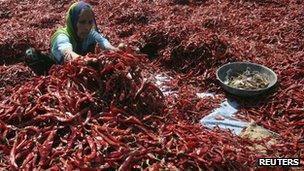The rural key to India's economic growth
- Published
As the leaders of Brazil, Russia, India, China and South Africa meet in Delhi for a Brics summit, the BBC's Sanjoy Majumder visits Punjab state to see why India has kept growing despite the global economic slowdown.
From the glass windows of his office, right above his barn, Sukhpal Singh Bhullar gazes out at his empire - a sprawling orange orchard that has reversed the fortunes of this farmer.
Two decades ago he was heavily in debt. But as India's economy grew, so did demand for the oranges he grows. He now earns $300,000 (£188,000) a year.
"It's really changed our lives. I only studied in the village school but I have sent my children to boarding school," he tells me, sipping a tall glass of freshly squeezed orange juice.
He has a fleet of cars and his house is stocked with all the luxuries you'd expect to find in the city - large television sets, a modern kitchen and electronic gadgets.
"I just want my family to have all the comforts of urban life. We no longer feel we are inferior to people in the city in any way."
Well-stocked
Just down the road is the main square of his village, Ghuman Kalan.
It's like any other Indian village - dirt tracks which pass for roads, women filling up water containers at the local hand pump and then taking them home.

India's countryside is still lacking in infrastructure
Rural India still suffers from poor infrastructure. There is still no proper health care or schools or power supply.
But over the past few years, the government has poured millions of dollars into rural welfare programmes.
Along with increased farm incomes, this has left many villagers with extra cash in hand.
The signs are everywhere, especially in the local markets where tiny shops are stocked with bottles of Coke and Pepsi, shampoos and soaps, mobile phones and small electronic goods.
"People have been spending a lot of money on things such as soft drinks and mobile phone recharge cards," says one shopkeeper.
"It's really benefited us."
Captive market
There are big spenders too.
Just off the highway is a Mahindra car dealership. The company specialises in pick-up trucks and sports utility vehicles - a big draw with farmers and villagers because of the poor roads in the countryside.
"Seventy per cent of our sales are to rural customers," says the sales manager, Sarabjit Grover.
"This includes both passenger and commercial vehicles. There's been a huge spurt in demand over the past year."
Urban Indians are spending less because of growing inflation and an economic slowdown.
But a recent study suggests that rural India now accounts for 20% of the Indian economy.
Two-thirds of Indians still live in villages. That's a captive population of nearly 800,000,000 - a market whose potential is only now being tapped.
It is one reason why, despite its slowing economy, India is still not being written off. Now it is hoping to translate this into global political clout.
- Published22 March 2012
- Published26 March 2012
- Published28 November 2011